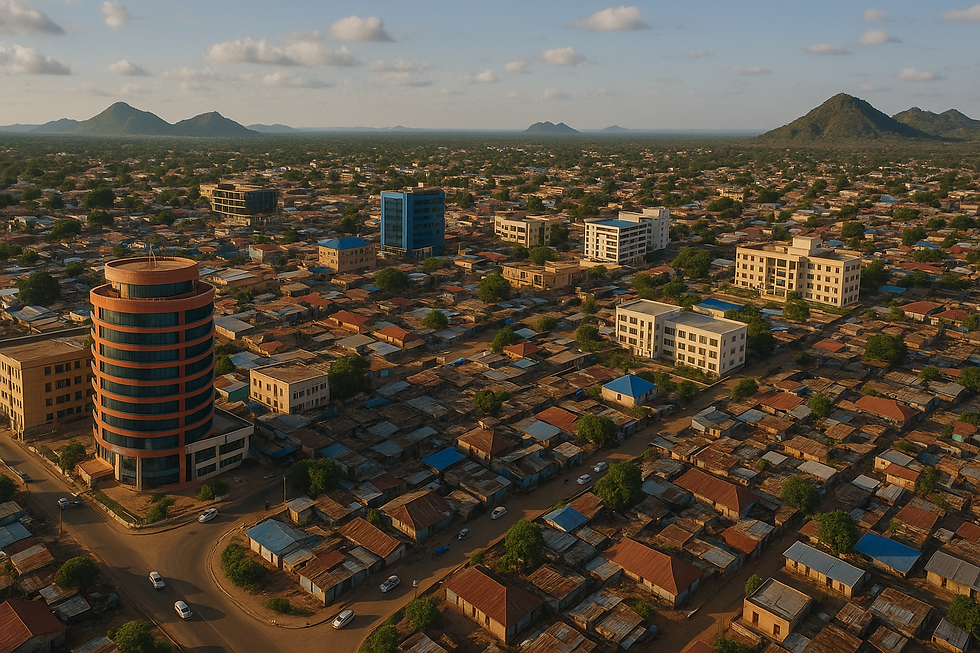South Africa’s ESG Reckoning: Power, People, and the Pursuit of a Just Transition
- tinchichan

- Jul 31
- 5 min read
Updated: Aug 1

South Africa is a land of paradoxes. It’s the most industrialized economy in Africa, yet grappling with chronic power shortages, deep inequality, and high unemployment. It’s a climate change hotspot, yet one of the world’s most coal-dependent nations. And it’s home to resilient civil society and world-class institutions, yet burdened by governance fatigue and state capture legacies.
Now, South Africa is at an ESG inflection point.
With a historic $8.5 billion Just Energy Transition Partnership (JETP) from G7 nations, a bold push for green industrialization, and renewed governance reforms, South Africa is attempting one of the world’s most complex ESG transformations—one that seeks to decarbonize without destabilizing, and reform without rupturing its fragile social contract.
“South Africa’s ESG journey cannot be copy-pasted from Europe,” says Barbara Creecy, Minister of Environment, Forestry and Fisheries. “It must reflect our realities, our people, and our history.”
1. ESG in Context: Reforming a Divided, Carbon-Intensive Economy
South Africa’s economy reflects both upper-middle-income strength and developing-country vulnerabilities:
GDP (2024 est.): $410 billion (nominal)
Population: 60.5 million
Unemployment: 32.9% (youth: 61%)
Gini coefficient: 0.63 (world’s highest inequality)
Public debt: ~72% of GDP
ESG priorities are shaped by a triple challenge:
Energy crisis and climate vulnerability
Social inequality and exclusion
Governance recovery and institutional confidence
South Africa’s 2024 elections have ushered in a Government of National Unity, setting the stage for coalition-backed reforms, policy stability, and ESG-aligned economic recovery.
2. Environmental Sustainability: From Coal Dependency to Climate Diplomacy
2.1 Energy Transition and Emissions Profile
South Africa is the 14th largest emitter of CO₂ globally, largely due to coal-fired power:
85% of electricity comes from coal (Eskom)
GHG emissions per capita: 7.6 tCO₂e (2023)
Eskom alone emits more than entire countries like Portugal or New Zealand
National targets:
Net-zero by 2050 (as per National Climate Change Response Strategy)
Updated NDC (2021): 420–350 MtCO₂e by 2030 (down from 614 Mt in 2020)
Coal phase-out by 2050, with early closures of aging plants
The Just Energy Transition Partnership (JETP) is a flagship ESG model:
$8.5 billion pledged by the EU, US, UK, and Germany
Blended finance for renewables, grid upgrades, and worker reskilling
Implementation led by the Presidential Climate Commission (PCC)
“The JETP is not just about energy—it’s about justice,” says Valli Moosa, PCC Commissioner and former Environment Minister.
2.2 Climate Adaptation and Natural Resources
South Africa is a climate risk hotspot:
Increasing droughts, floods, and wildfires
Agriculture and water systems under pressure
Cape Town’s “Day Zero” water crisis (2018) was a global wake-up call
Adaptation strategies:
National Climate Adaptation Strategy (2020–2030)
Climate-resilient agriculture in Limpopo, Eastern Cape, and KwaZulu-Natal
Nature-based solutions in biodiversity corridors (e.g., Cape Floristic Region)
The country is also pioneering climate risk disclosure through:
Green finance taxonomy (launched 2022)
Mandatory climate risk reporting under King IV Corporate Governance Code
3. Social Sustainability: A Just Transition or Just Another Promise?
3.1 Inequality, Poverty, and Social Protection
South Africa’s social fabric is strained:
18.2 million people receive social grants
Nearly half the population lives below the upper-bound poverty line
Informal employment dominates in rural and peri-urban areas
Social ESG interventions:
Basic Income Support (BIS) debate ongoing—pilot programs underway
Expansion of National Health Insurance (NHI)
School nutrition, early childhood education, and youth employment schemes
Yet structural inequality persists between:
Urban vs rural
Formal vs informal labor
Racial and gendered income gaps
3.2 Gender, Youth, and Inclusion
Gender and inclusion metrics:
Female labor force participation: 46.8%
Gender pay gap: ~28%
Women in Parliament: 46% (among the highest globally)
Policies advancing equity:
Gender-responsive budgeting and procurement
National Strategic Plan on Gender-Based Violence and Femicide
Youth employment tax incentives, YES Program (Youth Employment Service)
4. Governance: Rebuilding Trust, Reforming Institutions
4.1 Rule of Law and Anti-Corruption
South Africa’s post-apartheid governance record is mixed:
World-class judiciary and constitution
But state capture scandal (Gupta-linked corruption) eroded trust
Key reforms:
Zondo Commission findings adopted in part
Procurement reform and digital transparency mandates
New National Anti-Corruption Strategy (2020–2030)
Transparency International CPI (2023): 83/180Still below peers, but improving under multi-party accountability pressure
4.2 ESG Regulation and Corporate Disclosure
South Africa is a regional ESG regulation pioneer:
King IV Code of Governance requires ESG integration in corporate strategy
Johannesburg Stock Exchange (JSE) mandates ESG disclosures for listed firms
Financial Sector Conduct Authority (FSCA) enforces sustainability risk in pensions and insurance
Private sector trends:
ESG-linked financing deals exceed ZAR 50 billion (~$2.6 billion)
Banks using TCFD and SASB frameworks
Mining firms under pressure for environmental and human rights compliance
5. ESG Finance: Green Bonds, Impact Investing, and JETP Capital
5.1 Public and Sovereign Green Finance
South Africa issued its first sovereign green bond in 2023:
ZAR 3 billion (~$160 million)
Finances:
Solar mini-grids
Energy efficiency in hospitals and schools
Climate-resilient infrastructure
Cities like Cape Town and eThekwini (Durban) are issuing climate bonds and tapping green municipal finance from the DBSA and GCF.
5.2 Private Finance and ESG Innovation
ESG finance is growing rapidly:
ABSA, Nedbank, Standard Bank issuing ESG-linked instruments
Rise of impact investing funds focused on agriculture, circular economy, and township entrepreneurship
Development of a national carbon market under the Carbon Tax Act (2019)
South Africa’s Green Finance Taxonomy (2022) aligns with EU standards and guides:
Pension fund allocations
Blended finance with DFIs
Green SME lending via IDC and SEFA
6. Digital Sustainability: Smart Infrastructure and Green Innovation
South Africa is integrating ESG into its digital economy strategy:
Smart city pilots in Johannesburg, Tshwane, and Cape Town
Green ICT procurement policies
Digital platforms for climate risk data and ESG dashboards
Innovation hubs in Stellenbosch and Gauteng support:
Clean tech startups
Blockchain-enabled carbon tracking
Drone-based environmental monitoring
7. ESG Case Studies: South Africa in Action
Case Study 1: Eskom – Reinventing a Power Giant
Largest GHG emitter in Africa
Target: Net-zero by 2050
JETP funds used to:
Decommission coal plants
Build 3 GW of renewables
Retrain 28,000 workers
Case Study 2: Nedbank – ESG in Banking
First African bank to sign UN PRI and UNEP FI
Issues green and sustainability-linked loans
ESG risk integrated into credit scoring and portfolio stress testing
Case Study 3: Cape Town – Urban Climate Leadership
Net-zero by 2050, 100% renewables by 2035
Green building codes, EV infrastructure, and water resilience plans
SDG budgeting and climate adaptation dashboard for all districts
8. Comparative ESG Snapshot: Africa and G20
Indicator (2023) | South Africa | Kenya | Nigeria | Brazil | Indonesia |
GHG per capita (tCO₂e) | 7.6 | 0.4 | 0.7 | 2.2 | 2.3 |
Renewable electricity (%) | 11% | 90% | 80% | 47% | 18% |
ESG disclosure regulation | Mandatory (JSE) | Partial | Weak | Growing | Partial |
Sovereign green bond issued | Yes | Yes | No | Yes | Yes |
TI Corruption Rank (2023) | 83 | 126 | 145 | 104 | 115 |
*South Africa leads in ESG regulation, green finance infrastructure, and climate diplomacy, but faces challenges in emissions, inequality, and energy transition speed.
9. Strategic ESG Risks and Opportunities
Risks
Eskom debt and grid instability
Political fragmentation post-2024 elections
Slow pace of coal decommissioning
ESG reporting gaps in SMEs and informal sector
Opportunities
Scale up renewables and storage with JETP leverage
Expand ESG skills training and green jobs pipeline
Develop carbon market and biodiversity credits
Use green finance taxonomy to unlock blended capital
Promote just transition hubs in Mpumalanga and Limpopo
Conclusion: South Africa’s ESG Future Is Hard-Earned—And High Stakes
South Africa’s ESG journey is unique: it’s not just about green—it’s about justice. From power plants to policy halls, the country is navigating one of the most ambitious and politically sensitive transitions in the Global South.
If it succeeds, South Africa will not only decarbonize its economy—it will set a global benchmark for inclusive, democratic, and just ESG transformation.



Comments